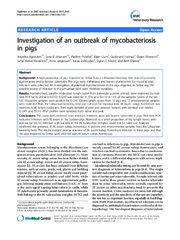Приказ основних података о документу
Investigation of an outbreak of mycobacteriosis in pigs
| dc.creator | Agdestein, Angelika | |
| dc.creator | Johansen, Tone B. | |
| dc.creator | Polaček, Vladimir | |
| dc.creator | Lium, Bjorn | |
| dc.creator | Holstad, Gudmund | |
| dc.creator | Vidanović, Dejan | |
| dc.creator | Aleksić-Kovačević, Sanja | |
| dc.creator | Jorgensen, Anne | |
| dc.creator | Zultauskas, Jonas | |
| dc.creator | Nilsen, Sigrun F. | |
| dc.creator | Djonne, Berit | |
| dc.date.accessioned | 2020-06-03T13:25:35Z | |
| dc.date.available | 2020-06-03T13:25:35Z | |
| dc.date.issued | 2011 | |
| dc.identifier.issn | 1746-6148 | |
| dc.identifier.uri | https://vet-erinar.vet.bg.ac.rs/handle/123456789/767 | |
| dc.description.abstract | Background: A high proportion of pigs imported to Serbia from a Lithuanian breeding herd reacted positively against avian and/or bovine tuberculin. The pigs were euthanized and lesions characteristic for mycobacterial infection were detected. An investigation of potential mycobacteriosis in the pigs imported to Serbia and the possible source of infection in the Lithuanian herd were therefore initialised. Results: Formalin fixed, paraffin embedded lymph nodes from tuberculin positive animals were examined by real-time PCR for IS1245 and IS6110. IS1245 was detected in 55% and IS6110 in 11% of the samples. Seven of the ten IS6110 positive samples were positive for IS1245. Eleven lymph nodes from 10 pigs and 15 environmental samples were collected from the Lithuanian breeding herd and cultured for mycobacteria. M. avium subsp. hominissuis was detected in all lymph nodes and from eight samples of peat and sawdust. Isolates with identical and related IS1245- and IS1311 RFLP profiles were detected from swine and peat. Conclusions: This study demonstrated cross reactions between avian and bovine tuberculin in pigs. Real-time PCR indicated infection with M. avium in the Serbian pigs. However, as a small proportion of the lymph nodes were positive for IS6110, infection with bacteria in the M. tuberculosis complex could not be ruled out. Analyses confirmed the presence of M. avium subsp. hominissuis in porcine and environmental samples from the Lithuanian breeding herd. The results indicate peat as a source of M. avium subsp. hominissuis infection in these pigs, and that the pigs imported to Serbia were infected with M. avium subsp. hominissuis. | en |
| dc.publisher | BMC, London | |
| dc.relation | Norwegian Research Council | |
| dc.relation | Norwegian Veterinary Institute | |
| dc.rights | openAccess | |
| dc.source | BMC Veterinary Research | |
| dc.title | Investigation of an outbreak of mycobacteriosis in pigs | en |
| dc.type | article | |
| dc.rights.license | ARR | |
| dcterms.abstract | Јоргенсен, Aнне; Aгдестеин, Aнгелика; Јохансен, Тоне Б.; Лиум, Бјорн; Холстад, Гудмунд; Aлексић-Ковачевић, Сања; Зултаускас, Јонас; Нилсен, Сигрун Ф.; Дјонне, Берит; Видановић, Дејан; Полачек, Владимир; | |
| dc.citation.volume | 7 | |
| dc.citation.spage | 63 | |
| dc.citation.other | 7: 63 | |
| dc.citation.rank | aM21 | |
| dc.identifier.wos | 000296974600001 | |
| dc.identifier.doi | 10.1186/1746-6148-7-63 | |
| dc.identifier.pmid | 22014189 | |
| dc.identifier.scopus | 2-s2.0-80054736622 | |
| dc.identifier.fulltext | https://vet-erinar.vet.bg.ac.rs/bitstream/id/1306/766.pdf | |
| dc.type.version | publishedVersion |

